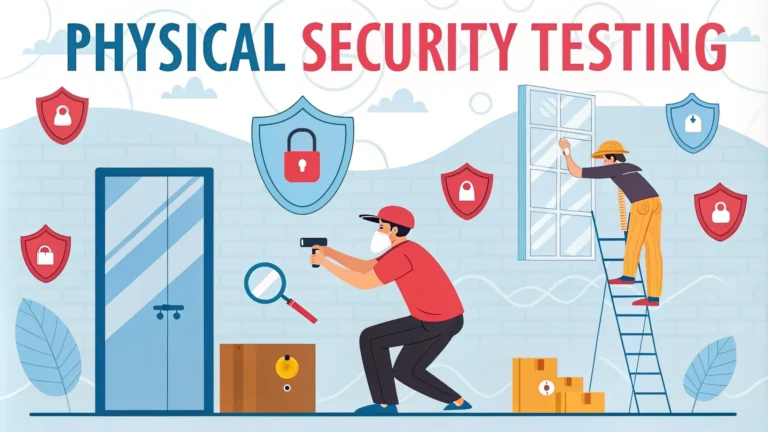Physical security penetration testing identifies vulnerabilities in an organization’s physical security controls before malicious actors can exploit them.
Security teams conduct authorized simulated attacks to evaluate building security, access controls, security personnel responses, and physical safeguards protecting critical assets.
This guide covers key aspects of physical security testing, methodologies, legal considerations, and ways to strengthen your facility’s security posture.
Key Components of Physical Security Testing
- Building perimeter assessments
- Access control system testing
- Security guard response evaluation
- Lock and key control analysis
- Camera system review
- Social engineering attempts
- Asset protection measures
Testing Methodology
A comprehensive physical security test typically follows these phases:
- Planning & Reconnaissance
- Define scope and objectives
- Obtain necessary authorizations
- Research target facility
- Document existing security measures
- Testing Execution
- Attempt unauthorized access
- Test physical barriers
- Evaluate security responses
- Document findings in real-time
- Analysis & Reporting
- Assess vulnerabilities found
- Prioritize security gaps
- Develop remediation plans
- Present findings to stakeholders
Legal Requirements
- Obtain written authorization from property owners
- Sign non-disclosure agreements
- Carry proper identification
- Notify local law enforcement when necessary
- Document all testing activities
Common Vulnerabilities
- Tailgating opportunities at entry points
- Weak access control systems that can be bypassed
- Poor key management practices
- Inadequate camera coverage or blind spots
- Insufficient security personnel training
- Unsecured sensitive areas within facilities
Strengthening Physical Security
Address these key areas to improve physical security:
| Security Component | Recommended Actions |
|---|---|
| Access Controls | Implement multi-factor authentication, regular access reviews |
| Surveillance | Install modern IP cameras, ensure complete coverage |
| Personnel | Regular training, emergency response drills |
| Barriers | Strengthen perimeter security, install proper lighting |
Finding Professional Help
Contact these organizations to locate certified physical security testers:
- ASIS International: www.asisonline.org
- Physical Security Professional (PSP) certification holders
- International Association of Professional Security Consultants
Next Steps for Your Security Program
Schedule regular physical security assessments to maintain an effective security posture.
Document and track all findings and improvements in a security management system.
Develop an ongoing training program for security personnel based on test results.
Maintaining Documentation
Proper documentation throughout the physical security testing process ensures:
- Compliance with legal requirements
- Clear tracking of identified vulnerabilities
- Evidence for security improvement recommendations
- Historical records for future assessments
Testing Frequency
Regular Assessments
- Quarterly access control testing
- Semi-annual guard response drills
- Annual comprehensive security audits
- Monthly security system checks
Event-Triggered Testing
- After security incidents
- Following major facility changes
- When new threats emerge
- Post-system upgrades
Cost Considerations
| Service Type | Typical Cost Range |
|---|---|
| Basic Assessment | $5,000 – $15,000 |
| Comprehensive Audit | $15,000 – $45,000 |
| Ongoing Monitoring | $2,000 – $5,000/month |
Building a Resilient Security Framework
Transform test findings into actionable improvements through:
- Regular stakeholder updates
- Continuous security awareness training
- Integration with risk management programs
- Budget allocation for security enhancements
- Periodic policy and procedure reviews
Securing Tomorrow’s Facilities Today
Physical security testing remains a critical component of comprehensive facility protection. Organizations must maintain vigilance through regular assessments, prompt remediation of vulnerabilities, and ongoing security awareness programs.
Successful security programs balance technical controls, human factors, and procedural measures while adapting to emerging threats and organizational changes.
Invest in professional testing services and maintain detailed documentation to ensure your facility’s physical security measures remain effective and resilient against evolving security challenges.
FAQs
- What is physical security penetration testing?
A comprehensive evaluation of an organization’s physical security controls and measures through authorized simulated attacks to identify vulnerabilities in physical barriers, access controls, security procedures, and human security awareness. - What are the main areas covered in physical security penetration testing?
Physical security testing examines perimeter security, access control systems, surveillance systems, locks and keys, security personnel procedures, tailgating prevention, visitor management, and social engineering vulnerabilities. - How often should physical security penetration testing be conducted?
Physical security testing should be conducted at least annually, after significant facility modifications, when new security measures are implemented, or when required by industry regulations and compliance standards. - What credentials or certifications should physical security testers have?
Professional physical security testers should possess certifications such as CPP (Certified Protection Professional), PSP (Physical Security Professional), or CPTED (Crime Prevention Through Environmental Design) certification. - What methods do physical security testers use?
Testers employ techniques including lock picking, clone card testing, fence climbing, dumpster diving, social engineering, surveillance detection, and testing of alarm response procedures. - What deliverables should be expected from a physical security penetration test?
A detailed report containing identified vulnerabilities, risk assessments, test methodologies used, successful breach methods, photographic evidence, and specific recommendations for security improvements. - How is physical security testing different from red team exercises?
Physical security testing focuses specifically on physical security controls, while red team exercises are broader and may combine physical, cyber, and social engineering attacks in complex scenarios over longer periods. - What legal considerations must be addressed before physical security testing?
Written authorization from property owners, scope agreements, insurance coverage, local law enforcement notification, and compliance with local laws regarding lock picking and security tool possession. - What are the common vulnerabilities discovered during physical security testing?
Common findings include tailgating opportunities, weak access control policies, poor key management, inadequate camera coverage, insufficient lighting, and gaps in security guard procedures. - How can organizations prepare for physical security testing?
Organizations should review insurance coverage, inform key personnel, secure sensitive areas, maintain normal security operations, and ensure proper documentation of current security procedures.







